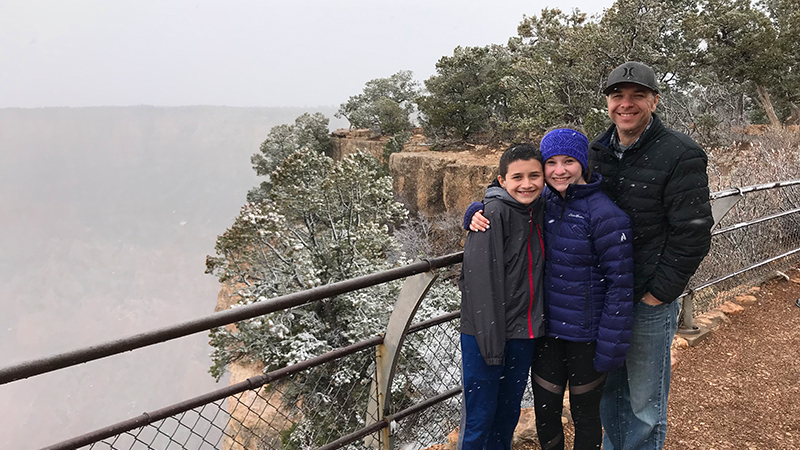
Grand Canyon, one of the seven natural wonders of the world, measures 277 river miles and is up to 18 miles wide and one mile deep. Along the South Rim in Grand Canyon National Park, the average elevation is 7,000 feet, which means it can get cold — really cold.
From mid-March through April overnight lows at Grand Canyon are ice cold — between 20-30 degrees on average — and day time highs average 50-60 degrees, but feel even colder when the wind picks up. And the wind will pick up. Winds along the canyon rim occasionally reach 40 mph. Believe it or not, you also need to be prepared for snow!
Snow At The Grand Canyon
We knew it was going to be cold during our spring break road trip to Grand Canyon National Park and Petrified Forest National Park, but we didn’t expect it to snow!
On our first day and a half at the Grand Canyon, we enjoyed clear, sunny, blue skies, but during our stops at Hopi House, Lookout Studio, and Kolb Studio in Grand Canyon Village, we heard rumblings that it might snow. WHAT?! As soon as we got to a spot with decent reception, Brian checked the weather and sure enough, snow was predicted for the next day. Thankfully, we packed lots of layers, gloves, and beanies!
The next day, the weather had clearly shifted. It was even colder than it was the day before — and it was freezing. The skies were also cloudy and gray. But we weren’t going to let that stop us. We planned to hike Hermit Road and checkout all the scenic viewpoints along the way and that’s what we were going to do, no matter what the weather was like.
As the day progressed, we did get some patched of sun through the clouds, but overall, the wind picked up, the clouds rolled in, and as we were hiking the Canyon Rim Trail between Hopi Point and Mohave Point, snow flurries began to fall from the sky and swirl around us.
It was snowing on us while hiking in Grand Canyon National Park and it was amazing!
The kids went nuts. For years they have wanted to actually be in falling snow, but it hadn’t yet happened. Normally, Brian never drives to the snow in bad weather, so we only go when the sun is out. And while we did try to time our last sledding trip to coincide with the start of a snowstorm, the snow was delayed and didn’t start for several hours after we headed home.
Who would have thought that the first time they would ever stand in falling snow would be on the edge of the Grand Canyon!?
Thankfully, the storm stayed fairly calm during our hike.
Flurries continued off and on all the way until we reached Hermit’s Rest. It then picked up a little on our shuttle ride back to Grand Canyon Village, and by the time we reached our truck at the Maswik Lodge, the snow was falling much harder and it was sticking! Soon the trees, shrubs, and rocks along the canyon walls were covered in a light, white dusting of snow.
The snow continued for a couple hours and even though we were all so flipping cold, we couldn’t resist playing in the snow. We had snowball fights, we danced in the snow, and we threw snowballs into the Grand Canyon.
It was truly an experience none of us will ever forget.
Know Before You Go
- Grand Canyon National Park is located 60 miles north of Williams, Arizona via Route 64 from Interstate 40, and 80 miles northwest of Flagstaff, Arizona via Route 180 in Coconino County, Arizona 86023.
- Download the South Rim Pocket Map with everything you need to know about visiting the Grand Canyon South Rim.
- In most places, there is no cell phone service or reception, and even when hotels claim to have wifi, it’s usually in the lobby or common areas only and it’s not very good.
- From mid-March to April overnight lows are ice cold — between 20-30 degrees on average — and day time highs average 50-60 degrees, but feel even colder when the wind picks up.













